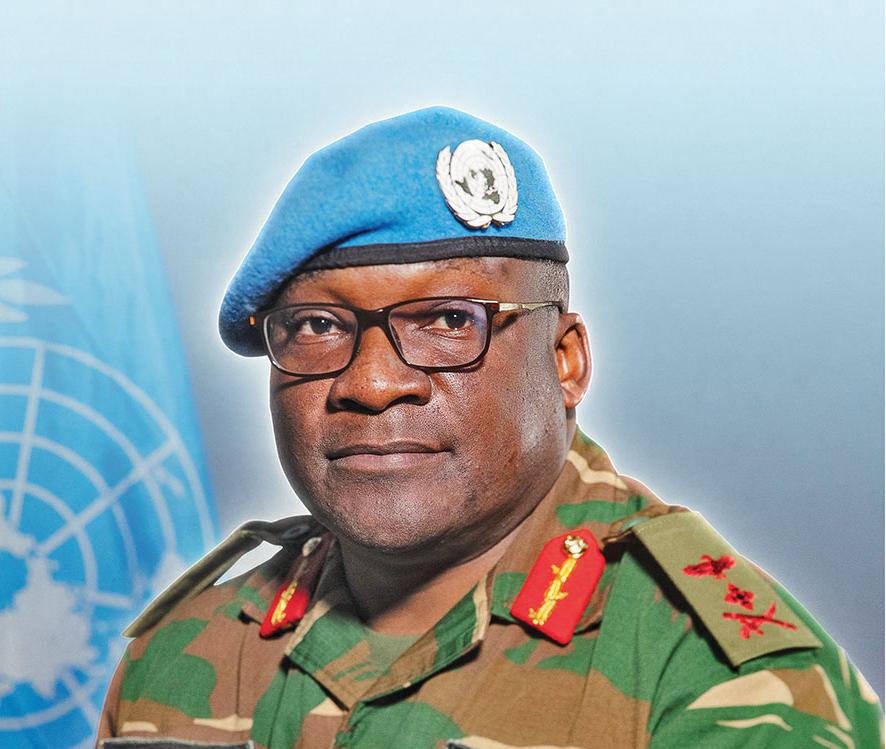Photos by MINUSCA
Lt. Gen. Humphrey Nyone has served in the Zambian military since 1994 and has held various roles, including commandant of the Defence Services Command and Staff College of Zambia, director-general for policy doctrine and strategy for the Zambia Army, and commander of the 1st Infantry Division. He previously served in United Nations peacekeeping missions in the Democratic Republic of the Congo and Sierra Leone. He was appointed force commander for the U.N. Mission in the Central African Republic (MINUSCA) in May 2023. He spoke to ADF by videoconference from Bangui. His remarks have been edited for space and clarity.
ADF: MINUSCA’s mandate was extended through November 2025 even as other U.N. missions on the continent have been forced to end or have faced resistance from host countries. How can MINUSCA fulfill its mandate and maintain public support?
Nyone: In peacekeeping, from my experience, most people will trust the mission if they see tangibles. Tangibles build public trust, and I think that is what we are doing in MINUSCA. From the time I joined, we really carried on with this trust.
So, what are we doing in this regard? Number one is the protection of civilians. Most of the areas where there were pockets of armed elements, we have established our footprint. And this is what people want to see.
Secondly, the special representative of the secretary-general [SRSG], Valentine Rugwabiza, using her good offices, has really revitalized the peace process. She is working hard because this was a process that was almost dead for a couple of years. We see now that it is coming alive, and we can see progress.
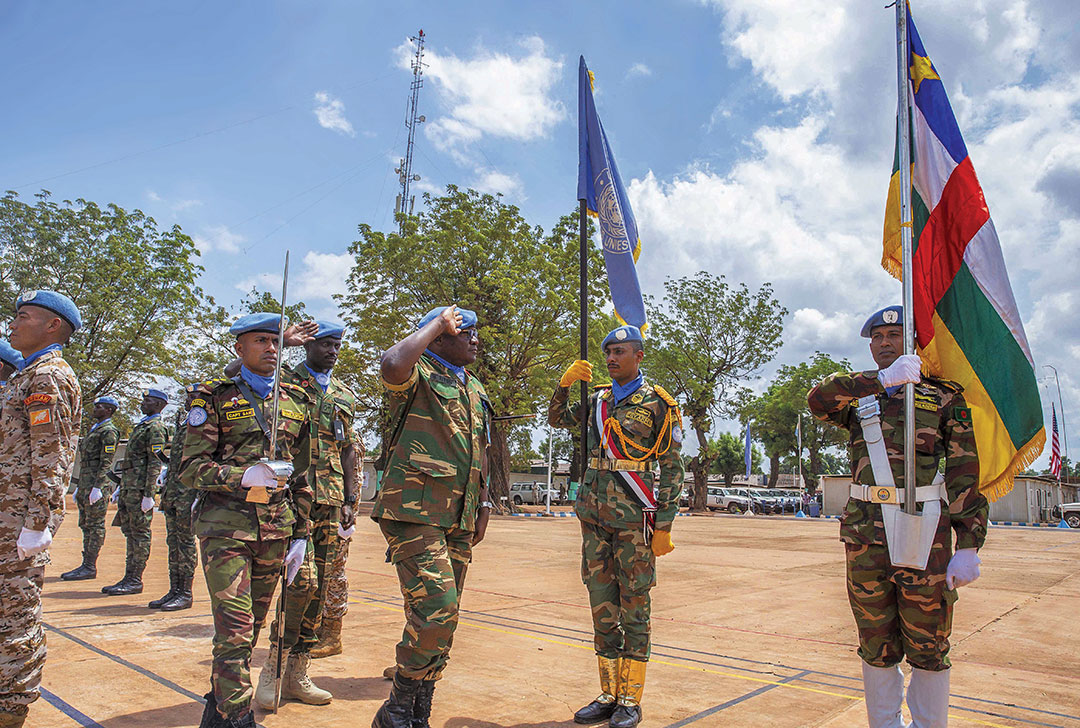
The number three issue, one of the lingering problems in terms of the conflict, is the issue of transhumance [moving animals to grazing lands]. Most of the animals migrate from Sudan or countries around and are brought to Bangui for slaughter; it’s business. But over the years they’ve been a target for attacks from the herders and also the armed groups. What the SRSG has done is to be able to sponsor some of these transhumance committees in most of the prefectures. Late last year we had a lot of transhumance conferences at the prefecture level, which the mission sponsored. Arising from that are some physical measures to support the internal security forces being led by the U.N. Police. They are working hand in hand with the CAR gendarmerie, the national police, and also we are behind this effort to ensure that we combat this particular aspect of transhumance.
There is also the issue of reconciliation. Social cohesion is a big issue in this country. The fault line was very vivid. The conflict was sectarian in nature. You can see the broken line separating people along religious lines or ethnic lines. There are a lot of efforts to bring this back together. This is being driven at the field level, where our heads of offices are overseeing local reconciliation programs to enhance social cohesion.
Lastly, we are operating in an environment where infrastructure does not exist. There was a total degradation of infrastructure. An example I can give is the road network. I will tell you that to traverse a distance of about 500 kilometers in this country, you will spend no less than four months. For air travel, most of the airfields were disused, so we had to rehabilitate them to be able to accommodate the air sector. We started using our engineering capabilities to build bridges, repair them, and we are doing a lot of grading of these roads. All this is to ensure that we create productivity, force mobility as well as movement of the local communities from Point A to Point B. This is what we’ve done because we believe peacekeeping is to build public trust. People must see tangibles, not just talk.
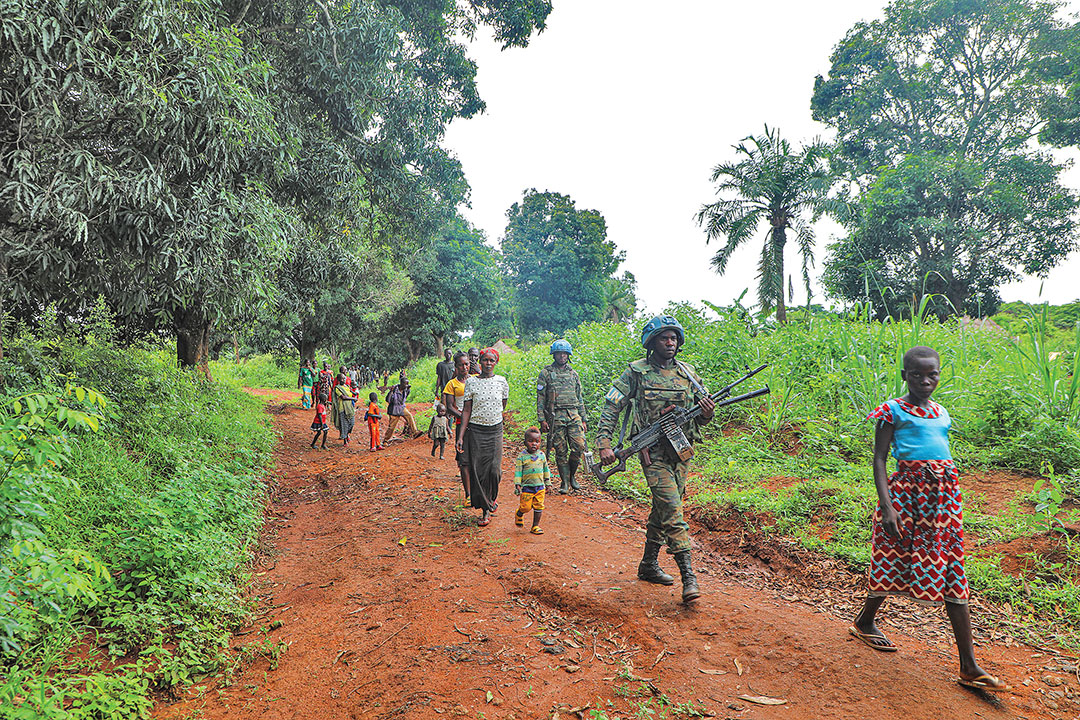
ADF: What is MINUSCA’s current strategy to protect civilians from harm, and how has this changed over the years? Do you have any evidence of recent success?
Nyone: We know that protection of civilians is always a multidimensional endeavor. It’s not only the force or the people in uniform; it’s all the entities of the mission.
We have a strategy based on three tiers: The first tier is protection through dialogue and engagement. We are fostering the peace dialogue, and we are supporting the upcoming elections. Second is physical protection. This is where we play a critical role as a force. When I came on, this mission was scattered with a lot of temporary operating bases [TOBs]. These had become more like military fortresses. The force didn’t have flexibility to be able to conduct patrols and dissuade the influence of these armed elements. We had to change our posture to be more mobile. We decided to close over 48 TOBs. We enhanced our early warning and enhanced our alert response, and we are going on more deterrence patrols. The third tier of our strategy is creating this protective environment. Mainly, this is being done by our colleagues in the humanitarian sector. We have a high influx of refugees, especially in the Vakaga, from the northeastern part of the country. They are coming in because of what is happening in Sudan, where there is renewed fighting. Every week we are receiving no less than 1,000 refugees. We now have 23,000 and when you look at the population of Birao, it’s only 16,000, so you have a higher number of refugees than residents. This creates a problem in terms of resources. Our humanitarian colleagues are really pushing hard, and the force is behind them to provide security escorts and timely intervention.
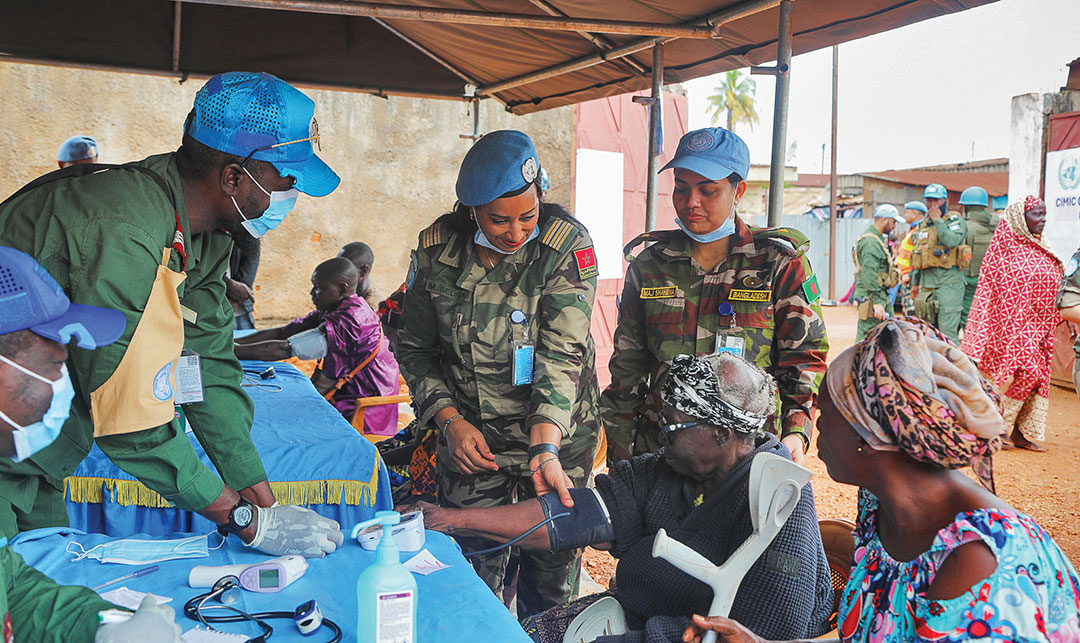
ADF: SRSG and Head of Mission Rugwabiza has called for a “proactive and preventative posture” of MINUSCA forces. What does this mean in terms of how your peacekeepers are positioned and how they respond to threats?
Nyone: The force is a mix. We are coming from different troop-contributing countries, and the forces have different doctrines, different cultures, different mindsets and different postures because of their training. When they come here you need to have a unity of purpose. When the SRSG made the speech, what she meant was changing the operational concept of the force to be more inclined to operations that are linked to a proactive response and also deterrence. To achieve this, first we had to work on our early warning system. We had a lot of bumps that we had to resolve with the help of our colleagues from civil affairs, mission chief of staff and also our heads of office. The force can only respond effectively if the early warning system is robust. Without us being fed that required information, it becomes very difficult. We wanted a shift from being reactive to being more proactive. We also looked at the mindset and posture of our force. Some of the contingents were risk averse. We have worked on this, and that is why we can now go into areas which have been a bastion of the Union for Peace [rebel group]. We intervene in those areas even using airlift, inserted by helicopters. You can only do that with a robust force that is not risk averse, with a good posture that, in case something happens, they’re ready to react.
ADF: MINUSCA has worked to improve the road infrastructure of the CAR. U.N. engineers have built or rehabilitated more than 2,000 kilometers of roads, 131 bridges and 37 airstrips in the past two years. How important for sustainable peace is it to allow commerce to thrive in the country, and what role do peacekeepers play in protecting this?
Nyone: At the inception of this mission, the concept of operational support was a lean concept, relying mostly on contractors. But as the mission expanded, we realized that we didn’t have the infrastructure in place to support it. The roads couldn’t support force mobility or the movement of the locals. The airstrips were not maintained and could not support air assets such as a C-130 [cargo plane], which could only land in two areas in the mission. The mission was not prepared. This country is almost 623,000 square kilometers and is crossed by rivers. It’s vast. So how do you sustain troops? How do you ensure protection of civilians? How do you extend state authority? It became very difficult. What we did was utilize the capabilities that we have at our disposal. We have five military engineering units. These units have both horizontal and vertical capabilities to construct buildings as well as roads, bridges and airstrips. The 2,000 kilometers of road they’ve rehabilitated is enabling food rations and other supplies to get to our troops in the deep field. The airfield capabilities mean C-130s are able to land there. It has made troop rotations easier. It also has allowed government representatives to go more places and visit the population. Humanitarian actors are using the same roads.
This country is sustained by a main road (MSR 1) that comes from the Port of Douala in Cameroon all the way to Bangui. Not long ago, the mission had problems. The road was shut by armed bandits. They literally blocked it for a couple of weeks. We could get no supplies from Douala. It took a lot of effort to expel those armed bandits and open that access. From then on, we dedicated two contingents that man that MSR. But we thought, ‘How sure are we that we won’t have another resupply problem?’ So, we worked to open another road, MSR 4, that is coming from Kenya via South Sudan through Bambouti and Obo, so we can open that in case the other one is closed for whatever reason.
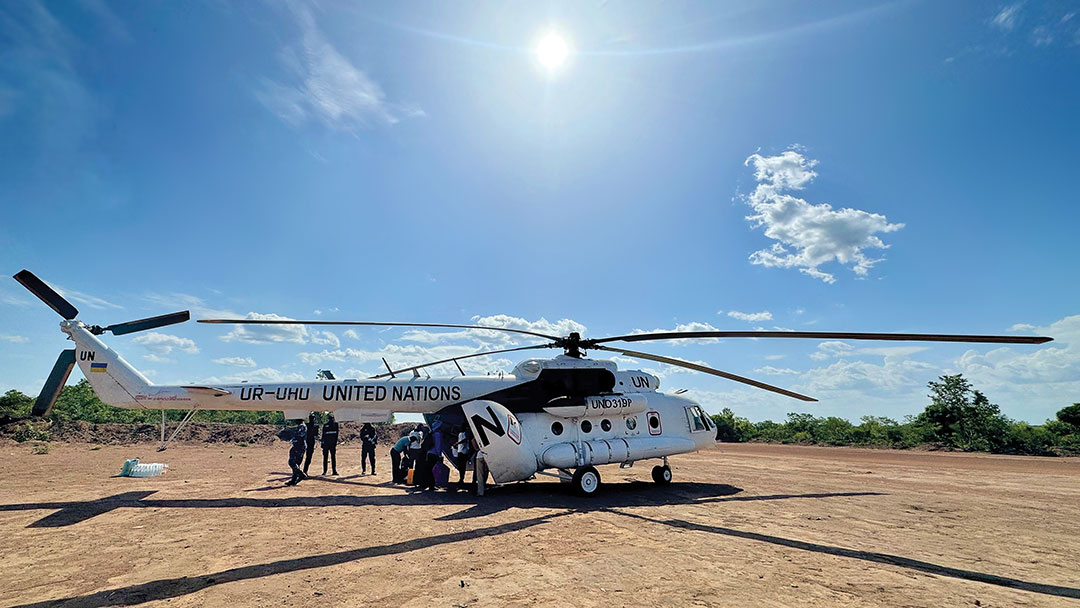
ability to travel across the country.
ADF: Many Central Africans are still displaced. An estimated 465,000 people are internally displaced, and 675,000 are refugees in other countries. What can MINUSCA do to create the conditions needed for these people to return home? Are you concerned about more refugees and spillover violence coming from the war in Sudan?
Nyone: I will start with the second portion. We are really concerned. The country is still stressed, and now you have an influx of refugees that completely chokes whatever resources are available. Secondly, there are the spillover effects. We want to make sure that war from different factions and different countries is not coming into the CAR. Otherwise, it changes the security dynamics and alters our stabilization efforts.
The internally displaced and the returnees — yes, we have a lot, but the statistics have drastically dropped. Most live among host communities. Most of them do not go to camps, but for those that do go to camps, the humanitarian agencies are there to provide water, food and medicine. Whenever there is movement, we provide the escort. We work hand in hand with our colleagues at the U.N. refugee agency.
ADF: MINUSCA peacekeepers have faced the threat of IED attacks. The first documented attack came in 2020, and another deadly attack happened at the beginning of 2024. The country also faces the threat of land mines and unexploded ordnance. How are your personnel combating this threat?
Nyone: When this first happened, our fear was it would spread across the mission. But it is localized in Sector West, and the incidents are going down. Our first question was, where are the mines coming from, is there a land mine field being harvested? Second, where are the networks? Because once you plug the source, you can be more secure.
What did we do? Working hand in hand with our colleagues at U.N. Mine Action Service (UNMAS) we have done capacity building for our contingents. We asked to bring in the mine-resistant vehicles for contingents in Sector West. We also built a search and detect capability within these contingents. We requested an explosive ordnance disposal (EOD) company, and U.N. Headquarters were quick to accelerate the deployment of the Cambodian EOD company.
Early in 2024, the SRSG sanctioned a pilot project. We realized that we had gaps in terms of awareness. Because the fatalities were not only the peacekeepers but most were the civilians who use the same roads. UNMAS spent a couple of months sensitizing the local population in Sector West, creating alert networks so that whenever there is a suspicious issue having to do with EOD, they will be able to alert us.
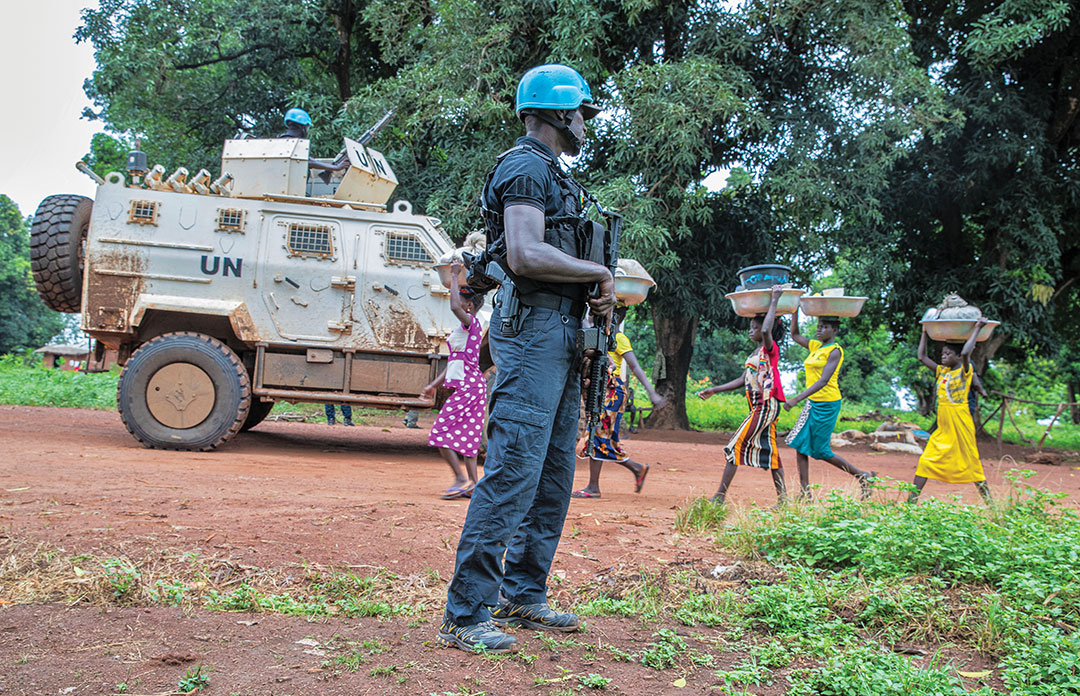
ADF: So, you’re trying to get locals to help stop these attacks?
Nyone: I’ll give you an example. When we had an incident in Nzakoundou in December 2023 [where 23 civilians were killed], I flew into the locality to assess the extent of the attack. We parked our helicopter about 3 kilometers out, and we walked that distance into the village and then back. When I was coming back from the village, I met the Cameroonian patrol that we had activated. Civilians who had been hiding in the bushes saw us and started coming toward us, and we interacted with them for about an hour and assured them of our support. The patrol, on its way back on the same road, hit an IED and we lost a peacekeeper and five others were injured. Later, the locals told us that they saw two armed elements on horses who were planting that device. They saw them planting it, and then they left. We saw there was a gap in terms of alerts. We started this pilot project, and we are seeing a lot of positive results. We are receiving a lot of information from the locals.
ADF: MINUSCA will help secure the country for upcoming legislative and presidential elections. What role will peacekeepers play in this process, and why it is important?
Nyone: This mission is going to be measured in terms of its performance if this election goes well. We’re not leaving anything to chance. An election is a contest between those that are jostling or vying for political leadership. What we should bear in mind is that the CAR last held local elections in 1988. Since that time, all local leadership positions such as mayor were presidential appointees. It was part and parcel of the [peace agreement signed in 2019] to hold these elections so the local population can elect their own leaders. MINUSCA will provide not only the technical, logistical and security support, but also to look at other marginalized groups, including women, to make sure they participate in these elections, not only by voting but also for those who aspire to leadership.
We have a plan for securitization of elections. We’ve already done Phase 1 of the voter registration; we are going to Phase 2, and we are working hand in hand with the national forces, police and gendarmerie to ensure that these elections are not disrupted.
ADF: It has been widely reported that Russian mercenaries continue to operate in the country and control access to certain mineral-producing regions. How do foreign mercenaries affect your mission? Do you have the ability to operate everywhere in the country?
Nyone: We have our mandate and clear objectives. Yes, they are operating in this environment. It is a contested environment in the sense that we are not the only actors. We also have the Central African Armed Forces [FACA], and we have armed groups in the same space. It’s a contested space, but our duty is to implement our mandate in this contested space. Our security partner is the FACA, so we collaborate with them and not any other group. In this country or this mission there is no area that is devoid of our presence. We have a mandate to traverse the CAR, and we’ve done it. Even in the areas that are hard to reach or controlled by armed groups, we’ve made inroads.
ADF: What are your goals for the remainder of your time as force commander?
Nyone: My goal is to contribute to the lasting peacekeeping legacy of the mission. The best legacy we can leave is lasting peace. When I look at Sierra Leone today, I smile because of our achievements there. Also, when I look at Liberia and what other U.N. missions have done, you will see success. That is what I am looking forward to. Now, how can I contribute to this legacy of stability in this country so citizens can again live normal lives? One is to ensure that we support the strategic objectives of the SRSG, like the extension of state authority. It becomes very difficult to stabilize a country if armed groups are active in some areas. What we are doing is the best approach. Extend the state authority, ensure the government can operate in those areas, support the deployment of the FACA and the ability of the FACA to be able to own the security of the country. I think those are my goals. And if I am able to contribute to this, when I go back home, I’ll look back and I’ll be smiling because I can say, ‘We did something.’

